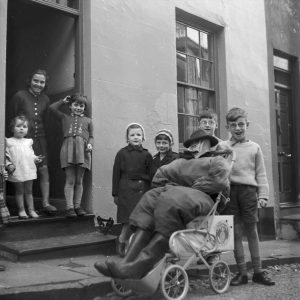
Britain’s many traditions and customs reflect the country’s rich cultural history. These celebrations are almost all tied to the agricultural calendar, local folklore, religious festivals, historical events, or communal identity. However, the relatively recent past has seen Britain undergo major technological advances, rapid urbanisation and mass immigration. These developments have fuelled a tremendous shift in Britain’s social norms. As a result, once well-supported customs and traditions have increasingly been forgotten.
Here’s a brief narrative on the once-popular children’s custom of ‘Penny for the Guy’:
Penny for the Guy

Geoff Charles, CC0, via Wikimedia Commons
The children’s cry of “penny for the Guy” could once be widely heard on Britain’s streets in the run-up to Bonfire Night (aka Guy Fawkes Night) on 5 November. ‘Guy’ refers to Guy Fawkes, the most notorious of the conspirators to the ‘Gunpowder Plot’ of 1605.
Guy Fawkes and Bonfire Night
The colluders of the Gunpowder Plot were a group of Catholics whose intention was to kill the King of England. The plan was to blow up Parliament with the protestant King James I in attendance. With the king dead, the master plan was to restore a Catholic monarch to the English throne. However, on 4 November 1605, Guy Fawkes was apprehended while guarding a consignment of gunpowder in a chamber beneath the House of Lords. Fawkes, along with the other 12 co-conspirators were either killed in the aftermath or hanged just a few months later.
The news of the attempted regicide spread quickly across the nation. Bonfires were lit nationwide to celebrate the plot being thwarted and the survival of King James the following day. In 1606, the ‘5 November Act’ was passed by Parliament to make Bonfire Night an official annual celebration.
‘Penny For The Guy’
The “penny for the Guy” tradition started sometime around the end of the 18th century. This saw children carrying an effigy of Guy Fawkes around the country’s streets on the days running up to Bonfire Night. In later times, the guy would usually be transported around in an old pram, wheelbarrow or hand-built bogey. The youngsters would then ask passersby for a ‘penny for the Guy’, or chant the popular rhyme:
‘Remember, remember, the fifth of November,
Gunpowder treason and plot;
I see no reason why gunpowder treason
Should ever be forgot.’
The money raised by the children was usually used to buy fireworks or sweets. The Guy’s, a scarecrow-like figure, ultimate fate was to be placed on top of the bonfire for burning. By the late 1960s, the tradition of ‘penny for the Guy’ had begun to die out mainly due to societal changes. Bonfires up to this time had largely been private events held in people’s gardens or on wasteland. However, it became increasingly difficult for children to buy fireworks due to safety concerns. Local authorities also began to regulate individual bonfires, replacing them with their own large-scale municipal events. Thus, by the early 1970s Britain’s long-running tradition of ‘penny for the Guy’ was all but dead.
Header Photo Credit: CC BY-NC-ND 2.0





